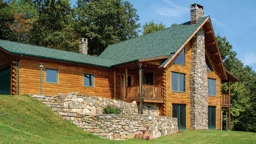
Photo Credit: Ken Chernus/Getty
Sometimes understanding the big picture of your castle is even more important than poring over the details. This is especially true when your home plans are in their infancy. We asked Jonathan S. Vincent, AIA, director of design at Timberpeg in West Lebanon, New Hampshire, to tackle some of the questions we hear most often.
See also 20 Tips for the Perfect Floorplan
Q: When it comes to planning a log home, what are the top three things I should consider about its design that will save money?
A: You first have to determine a realistic construction budget. From there, plan your home’s size—the square footage of heated and finished space—to match. Second, don’t get carried away by adding big-ticket items such as custom windows and granite counters. Finally, keep the plan simple. Every jog or angle adds both material and labor costs to a design.
Q: What about building a so-called hybrid home? Is it really possible to frame just one room of my home with timbers and conventionally frame the rest?
A: We often design houses with a timber-framed core with cathedral ceilings combined with conventional wings or second floors. Usually great rooms, kitchens and entries benefit from timber framing, while bedrooms, baths and utility spaces can be conventionally framed.
See also Favorite Spaces: Kitchens & Baths
Q: Does the type of truss system I choose impact the cost of my home? What’s the most affordable approach?
A: Trusses span longer distances between posts and support heavy snow or wind loads. They also can be used to add architectural interest and decorative elements to spaces with high ceilings. Generally, the more complicated the truss, the more expensive it is to build.
Q: How can a timber home save money on energy costs? Is energy efficiency related to design?
A: Timber homes are incredibly efficient. They typically use continuous rigid insulation or SIPs as enclosure systems, both of which are good insulators and limit air infiltration. Keep in mind, though, that your home should have a controlled fresh-air supply. Also, your house should be sited carefully and, if possible, face true south.
Q: What’s the best advice you can give to someone who’s in the planning stages of building a timber home?
A: Determine a realistic construction budget that allows for site and septic costs, and share this information with your designer. Design is always a series of choices, and accurate information leads to the best decisions.
Read the full story in the June/July 2005 issue of Timber Home Living.











